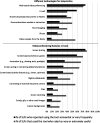Augmentative and Alternative Communication Telepractice During the COVID-19 Pandemic: A National Survey of Speech-Language Pathologists
- PMID: 34905413
- PMCID: PMC9135017
- DOI: 10.1044/2021_AJSLP-21-00036
Augmentative and Alternative Communication Telepractice During the COVID-19 Pandemic: A National Survey of Speech-Language Pathologists
Abstract
Purpose: The novel coronavirus (COVID-19) pandemic has led to sudden, widespread use of telepractice, including providing services to children who use aided augmentative and alternative communication (AAC). This exploratory study examined speech-language pathologists' (SLPs) experiences using telepractice to provide services to children and youth aged 3-21 years who used aided AAC during the earlier months of the pandemic (May-June 2020).
Method: Three hundred thirty-one SLPs responded to an online survey. Closed- and open-ended survey items were analyzed quantitatively and qualitatively and mixed at the point of interpretation to understand the experiences of SLPs related to the use of telepractice with children who use aided AAC, including how they perceived effectiveness.
Results: Most SLPs were using telepractice to provide both direct and consultation/coaching services to children who used aided AAC. There was fairly wide variation in perceptions of effectiveness of both types of services, but SLPs were more likely to rate consultation/coaching services as being more effective than direct services. SLPs identified factors impacting effectiveness across five dimensions: broader factors, practice-based factors (i.e., technology, the type of services), the child, parents and family members, and professionals. School-based SLPs perceived telepractice as being less effective than non-school-based SLPs.
Conclusions: The use of telepractice during the COVID-19 pandemic has unfolded quite differently for different SLPs and the children who use aided AAC that they serve. Although AAC telepractice offers promise for the future, particularly for partnering with families, further research is needed to know how to overcome challenges experienced by SLPs.
Supplemental material: https://doi.org/10.23641/asha.17139434.
Figures



Similar articles
-
Preparedness, Training, and Support for Augmentative and Alternative Communication Telepractice During the COVID-19 Pandemic.Lang Speech Hear Serv Sch. 2022 Apr 11;53(2):335-359. doi: 10.1044/2021_LSHSS-21-00159. Epub 2022 Mar 15. Lang Speech Hear Serv Sch. 2022. PMID: 35290095 Free PMC article.
-
Views of Speech-Language Pathologists on Telepractice for Children Who Use Augmentative and Alternative Communication.Intellect Dev Disabil. 2023 Feb 1;61(1):31-48. doi: 10.1352/1934-9556-61.1.31. Intellect Dev Disabil. 2023. PMID: 36706008
-
Augmentative and Alternative Communication Services During the COVID-19 Pandemic: Contextual Determinants of the Parent-Speech-Language Pathologist Partnership.Am J Speech Lang Pathol. 2023 Nov 6;32(6):2889-2907. doi: 10.1044/2023_AJSLP-23-00139. Epub 2023 Oct 6. Am J Speech Lang Pathol. 2023. PMID: 37801696
-
Developing Augmentative and Alternative Communication Competence in Preservice Speech-Language Pathologists: A Collaborative Model for Clinical Educators.Am J Speech Lang Pathol. 2024 Jan 3;33(1):1-15. doi: 10.1044/2023_AJSLP-23-00125. Epub 2023 Oct 18. Am J Speech Lang Pathol. 2024. PMID: 37850831 Review.
-
Speech-Language Pathologists' Experiences Working With Culturally and Linguistically Diverse Families: A Scoping Review.Am J Speech Lang Pathol. 2025 Mar 10;34(2):908-930. doi: 10.1044/2024_AJSLP-24-00185. Epub 2025 Jan 13. Am J Speech Lang Pathol. 2025. PMID: 39804966
Cited by
-
A comparison of referral and treatment patterns at child development institutes during the corona closures and pre-corona periods.Front Public Health. 2025 Jul 18;13:1447000. doi: 10.3389/fpubh.2025.1447000. eCollection 2025. Front Public Health. 2025. PMID: 40756395 Free PMC article.
-
Preparedness, Training, and Support for Augmentative and Alternative Communication Telepractice During the COVID-19 Pandemic.Lang Speech Hear Serv Sch. 2022 Apr 11;53(2):335-359. doi: 10.1044/2021_LSHSS-21-00159. Epub 2022 Mar 15. Lang Speech Hear Serv Sch. 2022. PMID: 35290095 Free PMC article.
References
-
- Akemoglu, Y. , Muharib, R. , & Meadan, H. (2020). A systematic and quality review of parent-implemented language and communication interventions conducted via telepractice. Journal of Behavioral Education, 29, 282–316. https://doi.org/10.1007/s10864-019-09356-3
-
- Allen, I. E. , & Seaman, C. A. (2007). Likert scales and data analysis. Quality Progress, 40(7), 64–65.
-
- American Speech-Language-Hearing Association. (2020). Telepractice services and coronavirus/COVID-19. https://www.asha.org/Practice/Telepractice-Services-and-Coronavirus/
-
- Anderson, K. , Boisvert, M. K. , Doneski-Nicol, J. , Gutmann, M. L. , Hall, N. C. , Morelock, C. , & Cohn, E. R. (2012). Tele-AAC resolution. International Journal of Telerehabilitation, 4(2), 79. https://doi.org/10.5195/ijt.2012.6106 - PMC - PubMed
-
- Beukelman, D. R. , & Light, J. C. (2020). Augmentative and alternative communication: Supporting children and adults with complex communication needs. Brookes.
Publication types
MeSH terms
Grants and funding
LinkOut - more resources
Full Text Sources
Medical

